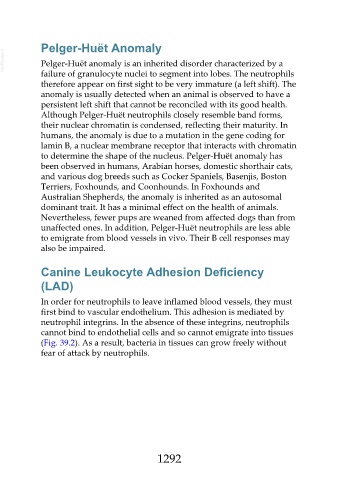Page 1292 - Veterinary Immunology, 10th Edition
P. 1292
Pelger-Huët Anomaly
VetBooks.ir Pelger-Huët anomaly is an inherited disorder characterized by a
failure of granulocyte nuclei to segment into lobes. The neutrophils
therefore appear on first sight to be very immature (a left shift). The
anomaly is usually detected when an animal is observed to have a
persistent left shift that cannot be reconciled with its good health.
Although Pelger-Huët neutrophils closely resemble band forms,
their nuclear chromatin is condensed, reflecting their maturity. In
humans, the anomaly is due to a mutation in the gene coding for
lamin B, a nuclear membrane receptor that interacts with chromatin
to determine the shape of the nucleus. Pelger-Huët anomaly has
been observed in humans, Arabian horses, domestic shorthair cats,
and various dog breeds such as Cocker Spaniels, Basenjis, Boston
Terriers, Foxhounds, and Coonhounds. In Foxhounds and
Australian Shepherds, the anomaly is inherited as an autosomal
dominant trait. It has a minimal effect on the health of animals.
Nevertheless, fewer pups are weaned from affected dogs than from
unaffected ones. In addition, Pelger-Huët neutrophils are less able
to emigrate from blood vessels in vivo. Their B cell responses may
also be impaired.
Canine Leukocyte Adhesion Deficiency
(LAD)
In order for neutrophils to leave inflamed blood vessels, they must
first bind to vascular endothelium. This adhesion is mediated by
neutrophil integrins. In the absence of these integrins, neutrophils
cannot bind to endothelial cells and so cannot emigrate into tissues
(Fig. 39.2). As a result, bacteria in tissues can grow freely without
fear of attack by neutrophils.
1292

